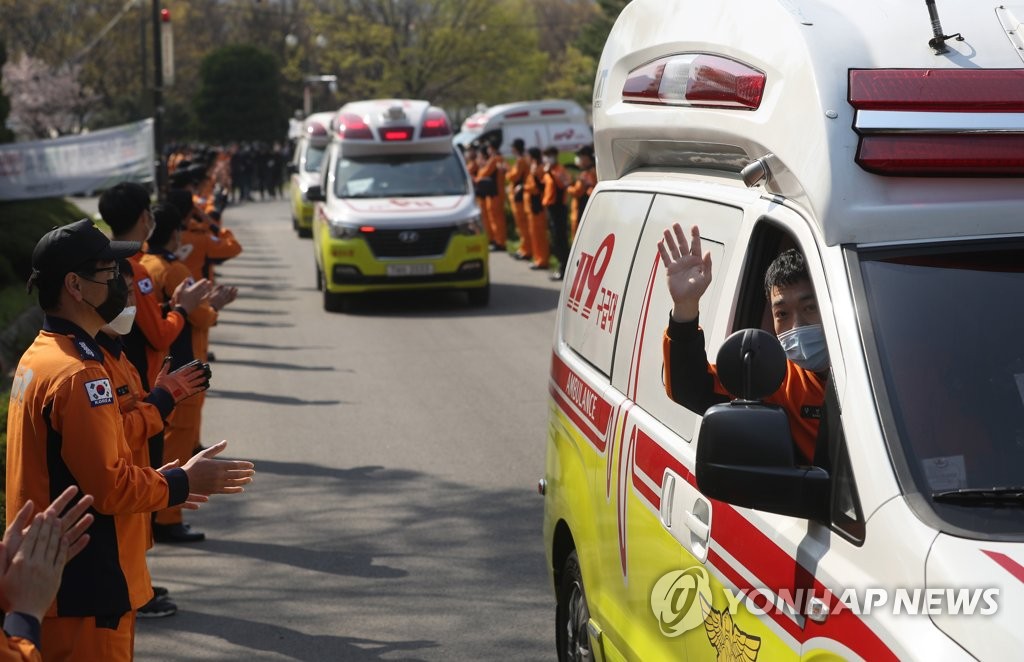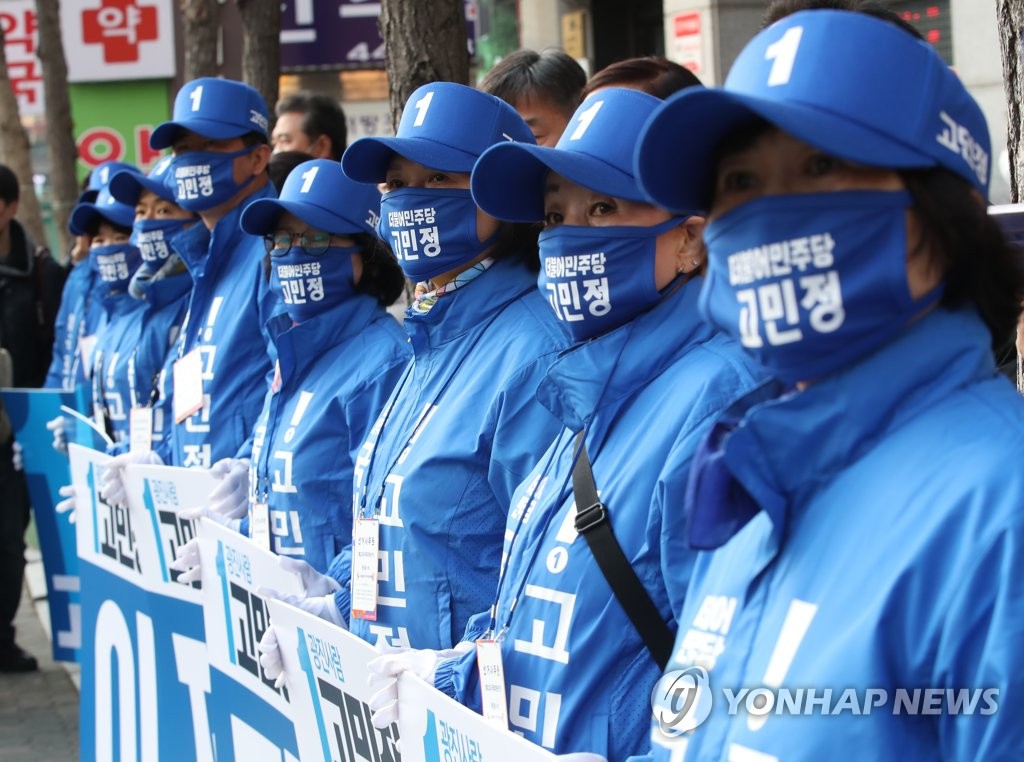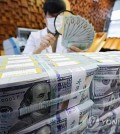- California Assembly OKs highest minimum wage in nation
- S. Korea unveils first graphic cigarette warnings
- US joins with South Korea, Japan in bid to deter North Korea
- LPGA golfer Chun In-gee finally back in action
- S. Korea won’t be top seed in final World Cup qualification round
- US men’s soccer misses 2nd straight Olympics
- US back on track in qualifying with 4-0 win over Guatemala
- High-intensity workout injuries spawn cottage industry
- CDC expands range of Zika mosquitoes into parts of Northeast
- Who knew? ‘The Walking Dead’ is helping families connect
Virus infections near 10,000 as cluster, imported cases keep rising
South Korea again saw a slight decline in new coronavirus cases Thursday, though the country remains wary of cluster infections and imported cases.
The 89 new cases of COVID-19, detected Wednesday and down from 101 new cases a day earlier, brought the country’s total cases to 9,976. It marked the 21st consecutive day that new infections have hovered around 100 or fewer additional cases, according to the Korea Centers for Disease Control and Prevention (KCDC).
The nation’s death toll rose by four to 169, with more than half of fatalities being patients aged 80 or older. Four more deaths were reported later in the day in the southeastern city of Daegu, but they have not yet been added to the official tally.
Of the 169 deceased, 102 contracted the virus through cluster infections, with 21 of them related to the Shincheonji minor religious sect. The KCDC said 158 fatalities, or 93.5 percent of the total, were reported in Daegu and the surrounding North Gyeongsang Province — the epicenters of the virus outbreak here.
All of the deceased had underlying health issues, except a man in his 70s, the KCDC said.



Firefighters and rescue officials gesture to one another as they return to their bases after being mobilized to Daegu to help fight the coronavirus in the city on April 2, 2020. (Yonhap)
Of the 89 new cases of COVID-19, 21 were in Daegu following mass infections at hospitals, while North Gyeongsang Province reported two new cases.
The total number of confirmed infections related to Miju Hospital in Daegu rose by 12 to 147, while those linked to Hansarang Convalescent Hospital in the same city increased by two to 123, the KCDC said.
The total number of cases reported in Daegu and North Gyeongsang Province reached 6,725 and 1,304, respectively.
Other major provinces and cities also reported infections, with Seoul and the surrounding Gyeonggi Province adding 14 and 17 cases, respectively, as they reported cluster infections at churches and hospitals.
The KCDC said the number of cases linked to St. Mary’s Hospital in Uijeongbu, north of Seoul, rose by nine to 22.
The country reported 36 new cases coming from abroad, with half of them detected at quarantine checkpoints, raising the total number of imported cases to 601.
The KCDC data showed 316 cases, or 52.6 percent of the total imported cases, came from Europe. Of the 601 imported cases, only 50 were foreign nationals.
Starting Wednesday, South Korea has required all arrivals to self-quarantine for two weeks to stem new coronavirus cases coming from abroad.
Visitors without local addresses are to stay in government-designated facilities at their own expense. All people in isolation must install a mobile app that allows authorities to monitor them in real time and ensure they are following the rules.
Health authorities said 7,558 travelers arrived in South Korea on Wednesday and 235 are currently being tested for COVID-19 after showing symptoms. They added 158 people had entered government-designated shelters for isolation Wednesday.
Of the 309 South Korean citizens who returned home from virus-hit Italy on a government-chartered plane Wednesday, 11 showed symptoms upon arrival and one tested positive for COVID-19, according to Vice Health Minister Kim Ganglip.
Others are currently receiving virus tests at temporary shelters.
The second chartered plane carrying some 200 evacuees from Italy will arrive in South Korea later Thursday.
Kim, however, said all 79 evacuees from Iran who arrived in South Korea on March 19 tested negative for COVID-19 in recent tests and they will be released from quarantine Friday.
South Korea has vowed no leniency toward those who breach quarantine rules. Starting Sunday, violators could face one year in jail or a fine of up to 10 million won (US$8,000). Foreigners could be expelled if they break quarantine rules.
Health authorities said 23,678 people have been ordered to self-quarantine, and 52 of them are facing legal action after violating quarantine rules. Six of them have been indicted for breaching the country’s infectious disease control law.
In the face of community spread of the virus, South Korea has been pushing for an extensive 15-day social distancing campaign since March 22.
Citizens are strongly urged to stay home, except for essential needs or jobs. The government has also strongly recommended people suspend religious gatherings, indoor sports activities and visits to nightclubs and other entertainment venues.
“As small cluster infections continue to emerge amid the novel coronavirus pandemic, people are urged to keep a social distancing campaign,” Kim said. “We will unveil the future direction of our social distancing campaign later this week.”
On Tuesday, the country pushed back the new school year to April 9, with the introduction of online classes. The opening of kindergartens and child care centers has been delayed indefinitely.
Health authorities also urged people to be considerate when posting about the coronavirus on social media.
On Wednesday, singer Kim Jae-joong of boy band JYJ drew criticism after he joked on April Fools’ Day that he had contracted the new coronavirus.
The KCDC said 5,828 patients have recovered as of Thursday, up from 5,567 the previous day, and 3,979 are receiving treatment, down from 4,155 the previous day. It marked the first time since March 1 that the number of COVID-19 patients undergoing medical treatment fell below 4,000.
The country has conducted virus tests on 431,743 people since Jan. 3. The virus was first detected in the country on Jan. 20.











